Saint Thomas divine, / brewing, baking...
December 21: Thomasmas (Hearthside, Table, & Field)
Saint Thomas divine,
brewing, baking, & skilling of fat swineTraditional rhyme
In our modern world, it’s easy to feel either swept up by the tide of frenetic energy as we approach Christmas, or feel somewhat unmoored as we attempt to slowly navigate the seasons - especially during Advent - without cultural backing. Trying to fold older, more obscure holidays into our rhythms at home can feel artificial when we don’t have the cultural context to support them.
In looking at the role that some of these lesser-known holidays (like Thomasmas) played in older, more agrarian-based homes & communities, though, we can distill what we learn into celebrations that are authentic & meaningful…celebrations that help us enlarge our faith.
Thomasmas was an opportunity to set aside time for tangible Christmas preparations - the day by which Christmas ale would have been brewed & holiday bread baked, & all the meat processed… a boundary that fostered calm & space between the solstice and the Nativity celebration that would follow just a few days later.
Let’s dip into a few ways to bear this out in our homes!
Something Baked & Something Brewed

In the apocryphal Acts of Thomas, we learn about St. Thomas’ mission throughout Parthia and India - and of all the stories related in this text, the one that has become most emblematic of Thomas’ faith has been an account of his surprising role as an architect. In countless portrayals of St. Thomas in both art and architecture, we see the apostle bearing his symbolic standard: a carpenter’s square.
King Gundaphorus (of India) commissioned St. Thomas to design and build a grand palace, providing the apostle with funds for the palace’s construction. Thomas, however, felt called by God to instead distribute the palace funds to the poor. The King inquired of his friends about this,
…[a]nd they told him: “Neither hath [St. Thomas] built a palace nor done aught else of that he promised to perform, but he goeth about the cities and countries, and whatsoever he hath he giveth unto the poor, and teacheth of a new God, and healeth the sick, and driveth out devils, and doeth many other wonderful things; and we think him to be a sorcerer. Yet his compassions and his cures which are done of him freely, and moreover the simplicity and kindness of him and his faith, do declare that he is a righteous man or an apostle of the new God whom he preacheth; for he fasteth continually and prayeth, and eateth bread only, with salt, and his drink is water, and he weareth but one garment alike in fair weather and in winter, and receiveth nought of any man, and that he hath he giveth unto others.” […]
And [Gundaphorus] sent for the merchant which had brought him, and for the apostle, and said unto him: “Hast thou built me the palace?” And [Thomas] said: “Yea.” And the king said: “When, then, shall we go and see it?” but he answered him and said: “Thou canst not see it now, but when thou departest this life, then thou shalt see it.”1
In distributing all of the king’s palace-building wealth to the poor and the afflicted, St. Thomas had indeed built Gundaphorus a palace - an eternal dwelling, though, rather than a temporal one.
[Converted, King Gundaphorus prays,] “…that I may become a worthy inhabiter of that dwelling for the which I took no pains, but thou hast builded it for me, labouring alone, the grace of thy God working with thee, and that I also may become a servant and serve this God whom thou preachest.”
Like an echo of Christ’s arc of accomplishment, St. Thomas was a bridge for a measure of grace unearned by the king - an architect of eternal dwelling-places, a builder of souls.
As we celebrate St. Thomas on the darkest night of the year here on the farm, we find that the larder is decidedly wintry: roots, grains, and meat are the staples available now. Exploring the traditional meals of the solstice Thomasmas, it’s unsurprising to find that our rural forebears planned their feast table around grains. Bread - sometimes made especially festive with dried fruits preserved from the summer harvest - was a focal point of Thomasmas celebrations.
We see long-standing Thomasmas traditions of farmers donating their grain to the local miller, who in turn would mill it and donate the flour to the poor for Christmas bread-baking. In Germany, superstitious bakers would pause their kneading of kletzenbrot (dried fruit bread) dough to go outside and hug the trees in their orchard, with an eye toward procuring a plentiful harvest.
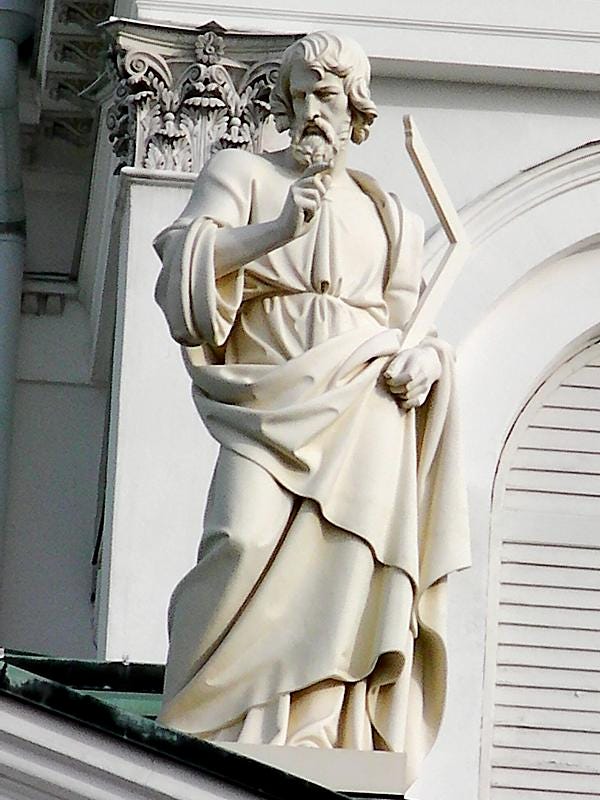
To simultaneously embrace the spiced flavor of preparations for Christmas, the wintry Thomasmas staple of bread, and St. Thomas’ renown as an architect, here’s a perfect opportunity to make a seasonal classic: gingerbread houses.
If you’re like me, though, you might find the idea of balancing all those pieces of gingerbread to be daunting…so, we’re digging into a Medieval gingerbread recipe to create a flat-lay of a house, with a nod toward St. Thomas’ design prowess:
And the apostle took a reed and drew, measuring the place; and the doors he set toward the sunrising to look toward the light, and the windows toward the west to the breezes, and the bakehouse he appointed to be toward the south and the aqueduct for the service toward the north.
Though my little design doesn’t have anything as lovely as a bakehouse or windows catching westward breezes, I do have a wintry stencil template (an extra for my paid subscribers) for crafting a Thomasmas house with some Tudor flair! And a little bunny waiting to hop inside, of course.
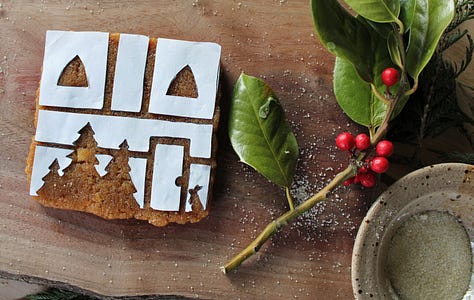
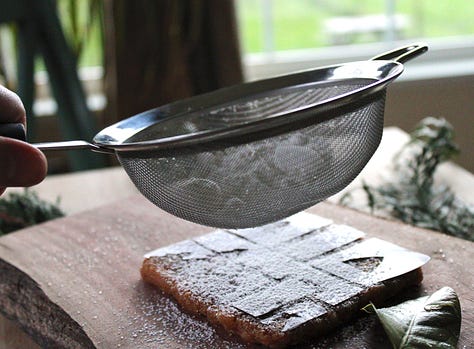
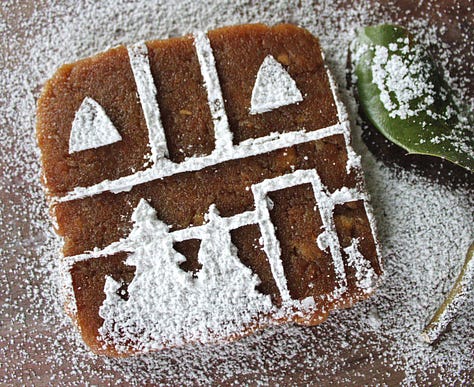
The recipe I’m leaning on comes from a 14th or 15th century manuscript2 - and, as you’ll see, Medieval gingerbread was quite different from what we expect today. More a marzipan-like confection than a bread or biscuit, it’s simple, flavorful, and versatile.
From the Medieval manuscript, with lots of footnotes to help us through its language:
To make gingerbrede. Take goode honye & clarefie3 it on the fere, & take fayre paynemayn4 or wastel brede & grate it, & caste it into the boylenge hony, & stere it well togyderfast with a sklyse that it bren not to the vessel. & then take it doun and put therin ginger, longe pepere5 & saundres6, & tempere it up with thin hands; & than put hem to a flatt boyste & strawe theron suger, & pick therin clowes7 rounde aboute by the egge and in the mydes8, yf it plece you, &c.
With honey as the sweetener, this is a great opportunity to seek out your local beekeepers and support them during the winter months; we’re thankful to have our friends from Rainy Day Bees, who keep hives here on the farm and throughout the Seattle area!
Since the gingerbread will be soft after kneading it, you can simply spread it on a tray and then use my stencil (or one of your own design!) to plot out the gingerbread house - place the stencil pieces over the gingerbread, sift some powdered sugar over the top, and then gently remove the stencils…voila! A Thomasmas gingerbread house.
The Medieval recipe also recommends placing cloves around the edge, too (gingerbread is a great way to dispel the myth that Medieval cookery was flavorless and bland!)
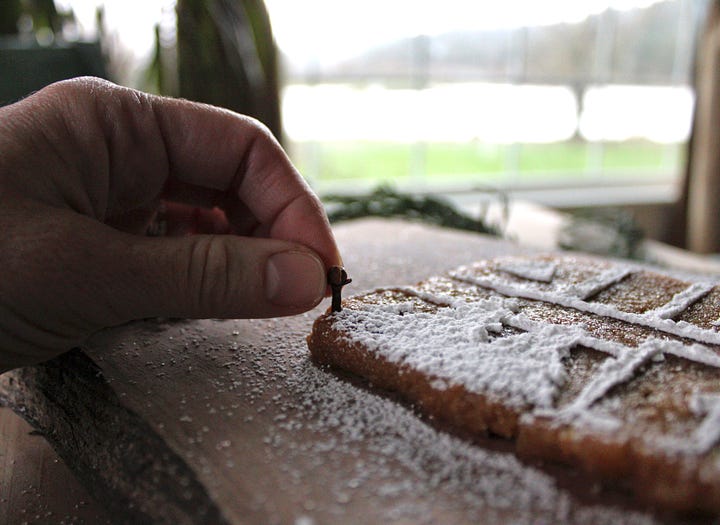
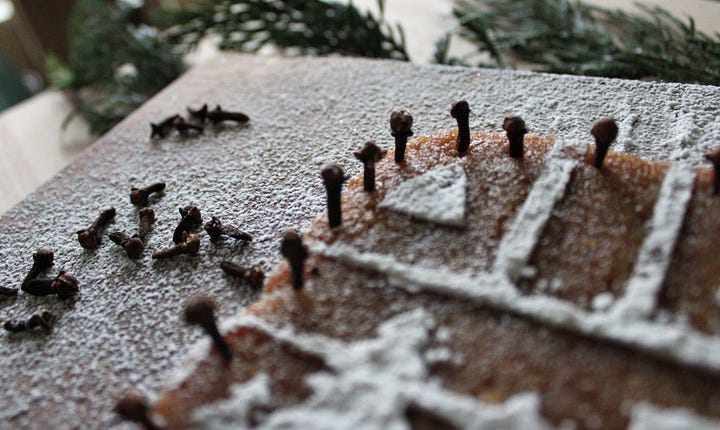
As always, make a double-batch: form the second batch of gingerbread into balls and roll them in sugar, making for easy gifting (more on that in my next post!) Especially if you have little hands helping you - or, if your threshold for baking stress is low - just making gingerbread balls is an easy solution.
Our littlest shaped the dough into balls, and then rolled them in vanilla sugar (for extra festive flavoring!)

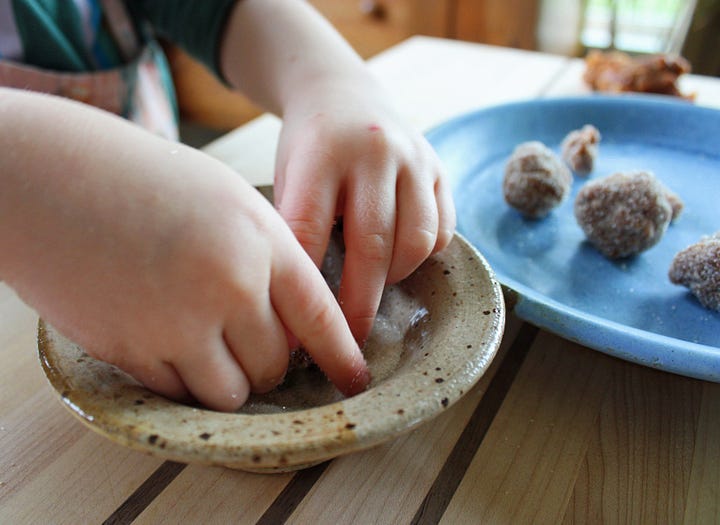
Here’s my adaptation of the Medieval gingerbread recipe…a free printable for everyone!
…and please hop over to the Scriptorium to find my wintry printable stencil:
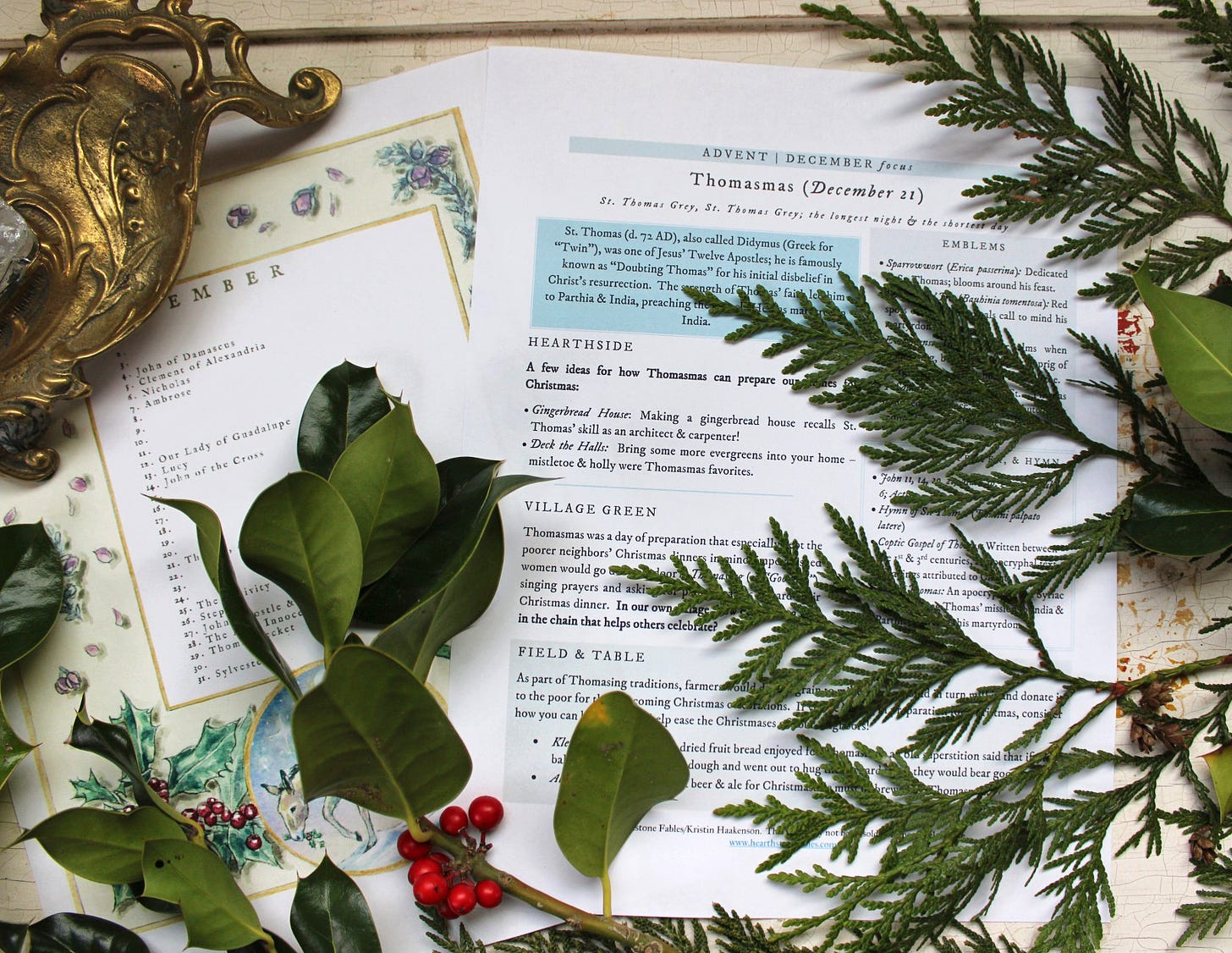
If you’re inclined & able, toast your gingerbread with some beer or ale, too. Our agrarian forebears held that all their slaughtering, baking, and brewing for Christmastide festivities must be done by Thomasmas (hence giving the apostle Thomas the nickname “St. Thomas the Brewer”).
Setting the solstice as a boundary for these crucial farm & kitchen tasks exemplified the Advent wisdom that has slowly waned in modern culture, but is still there for the taking: by setting boundaries (like brewing all the Christmas ale by Thomasmas), we’re acknowledging our own limitations, our own tendency toward frenetic distraction. And, in honoring those boundaries, we set aside space for unhindered celebration, cultivating Christmastide focus rather than diffusing our attention.
Don’t forget…the liturgical calendar isn’t meant to be a burden. I personally love the Middle Ages, so I gravitate toward that flavor of food & craft - but making a gingerbread house out of some graham crackers and rainbow-chip frosting is great, too (or just eating the crackers & frosting, and forgoing the whole house thing! Or not doing any of it! Go with what transports you joyfully and thoughtfully into catechesis). It’s about finding a lens through which we can learn about Christ and fold our life into his.
I’m especially thankful for the reminders of liturgical variety we’re seeing in our new Signs + Seasons guild - have you visited yet? Our first issue is filled with so many voices, from friends in the Southern Hemisphere, to Orthodox perspectives, and more.
When we next chat & wrap up our exploration of Thomasmas, I’ll be sharing some ideas for how we can bring these heritage traditions into our villages.
In the meantime, let me know: where are you on the gingerbread spectrum - do you love or dread constructing those little houses?
Pax vobis,
Kristin
If you’d like to make a one-time donation, I have a PayPal Tip Jar - please know that I’m so grateful for your monetary support, which really does help me continue to do this work that I’m so passionate about!
For those who are able to support a monthly or annual paid subscription, I offer occasional new printables, extra posts, and access to my whole library of printables: the Scriptorium. I’m so grateful for your generosity, which helps to support my work through the purchase of additional books for research, art supplies, and more!
For more reflections and perspectives on the liturgical year, please visit Signs + Seasons: a liturgical living guild!
Acts of Thomas: https://www.earlychristianwritings.com/text/actsthomas.html
BL MS Sloane 221. Sir Hans Sloane collected a variety of manuscripts, now held by the British Library.
Clarifying honey is a process to de-crystalize it…but our honey isn’t clarified, so I’m skipping this step.
Stale bread.
Popular in Greece & Rome, long pepper is something I don’t have in our pantry - so I’m substituting peppercorn, though its flavor profile isn’t as complex.
Saunders/sanders was a spice popularly used in Medieval cooking - food-grade red sandalwood, often used to give gingerbread a red color. Perfect for holiday festivities, if you can find this spice!
Cloves were often dotted throughout gingerbread, sometimes pricked through leaves.
We’re advised to decorate the edges and middle of the gingerbread with cloves!


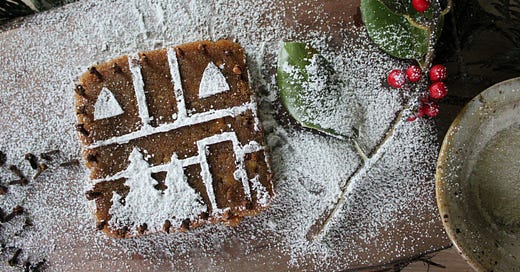



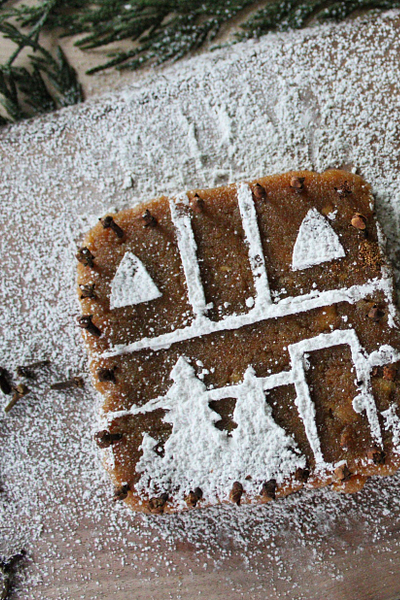
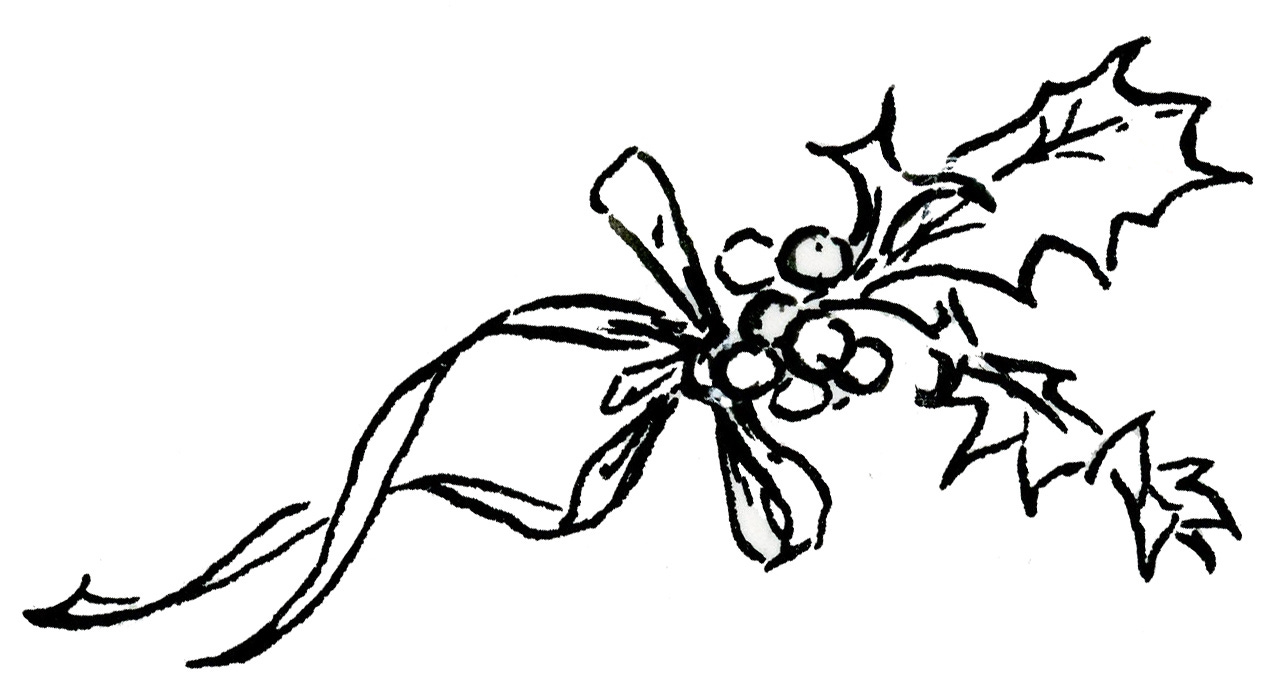
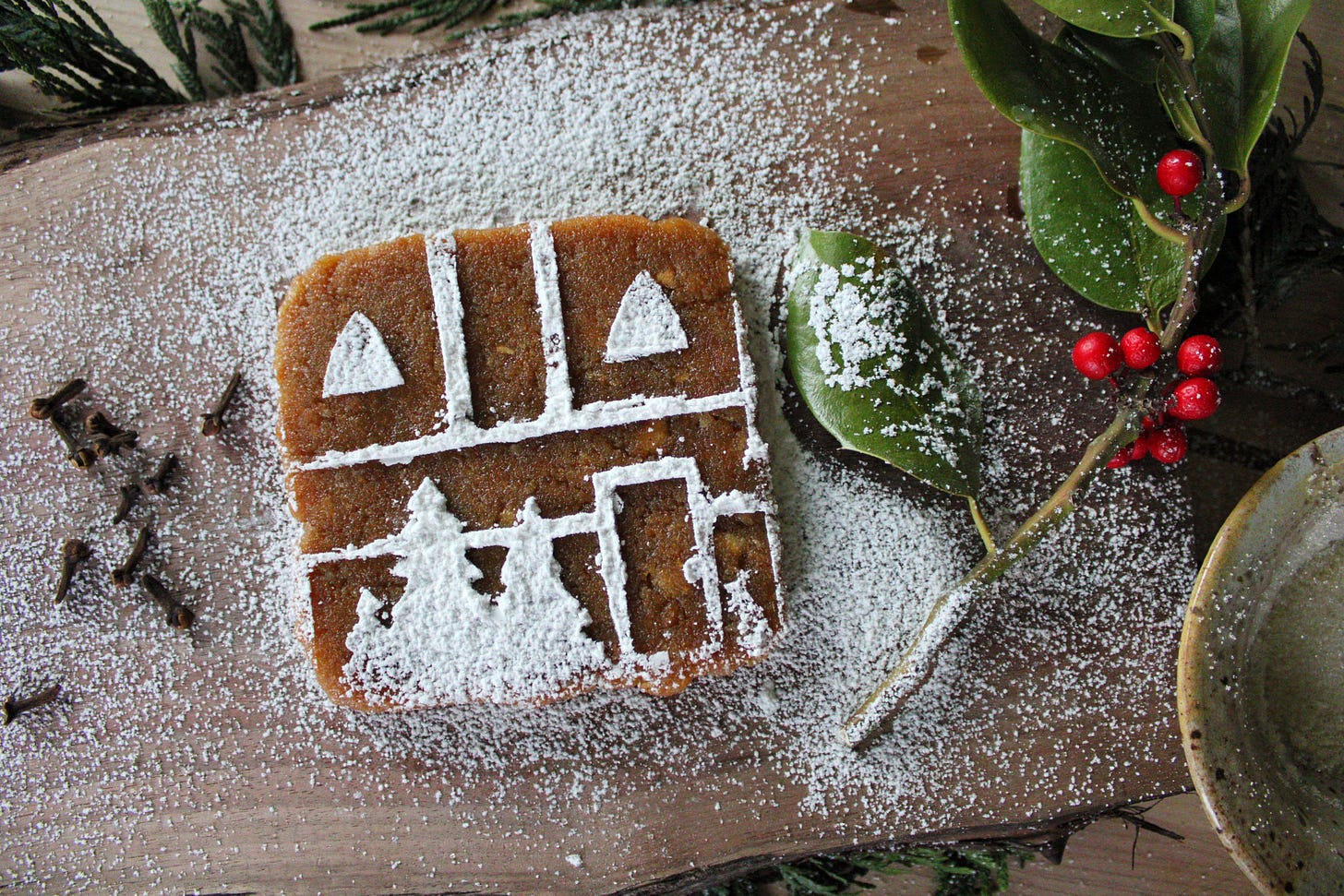

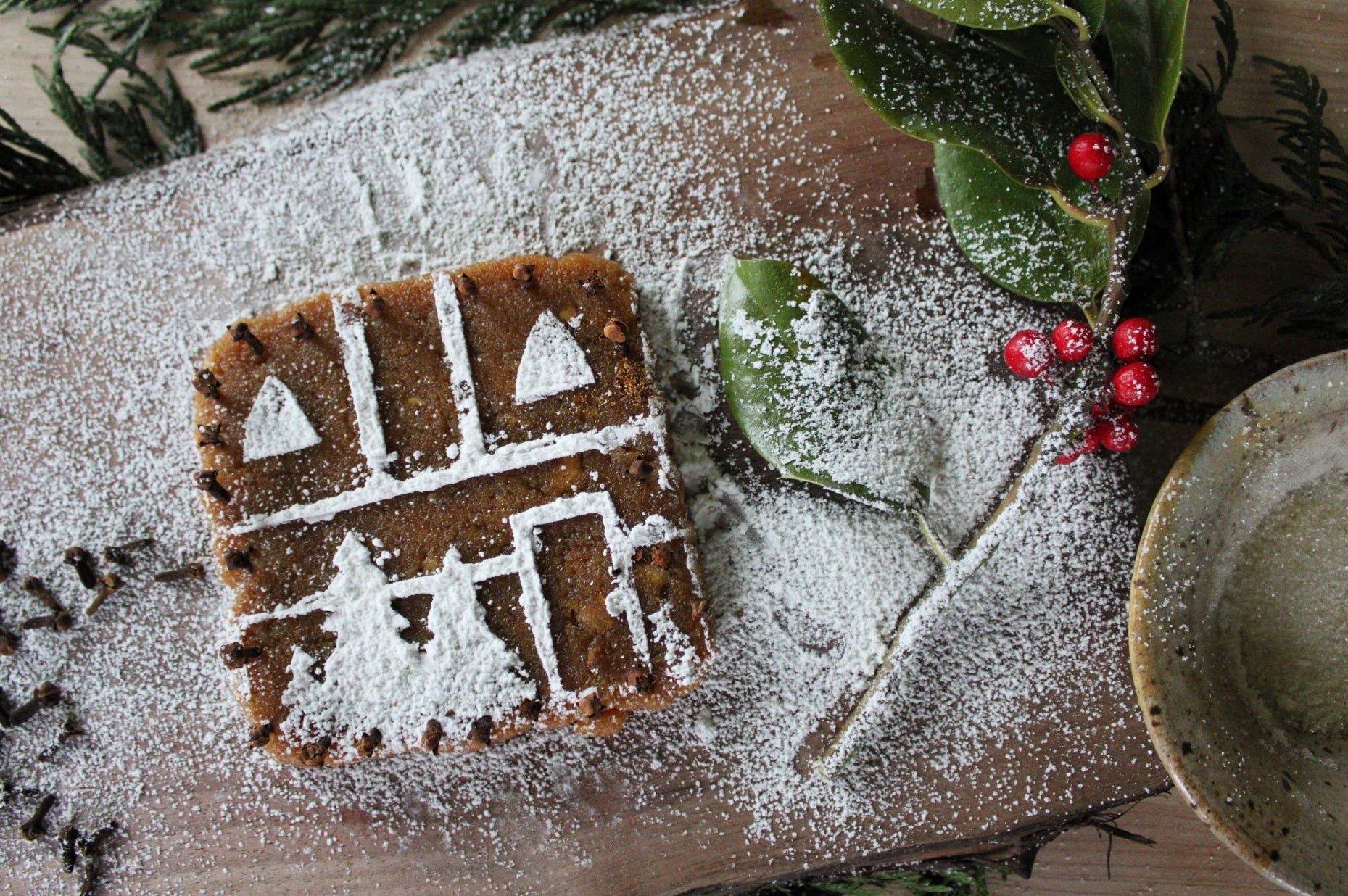
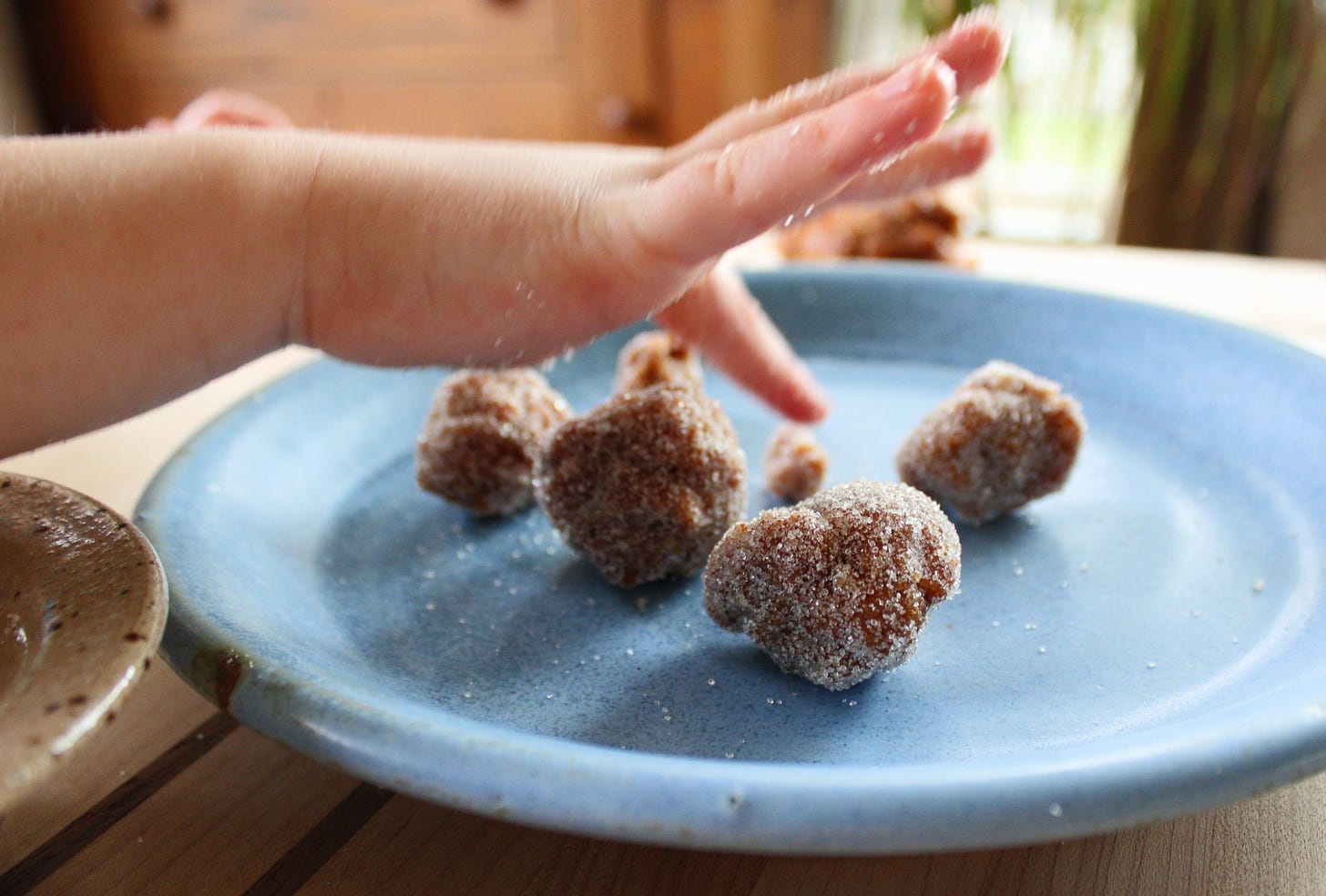

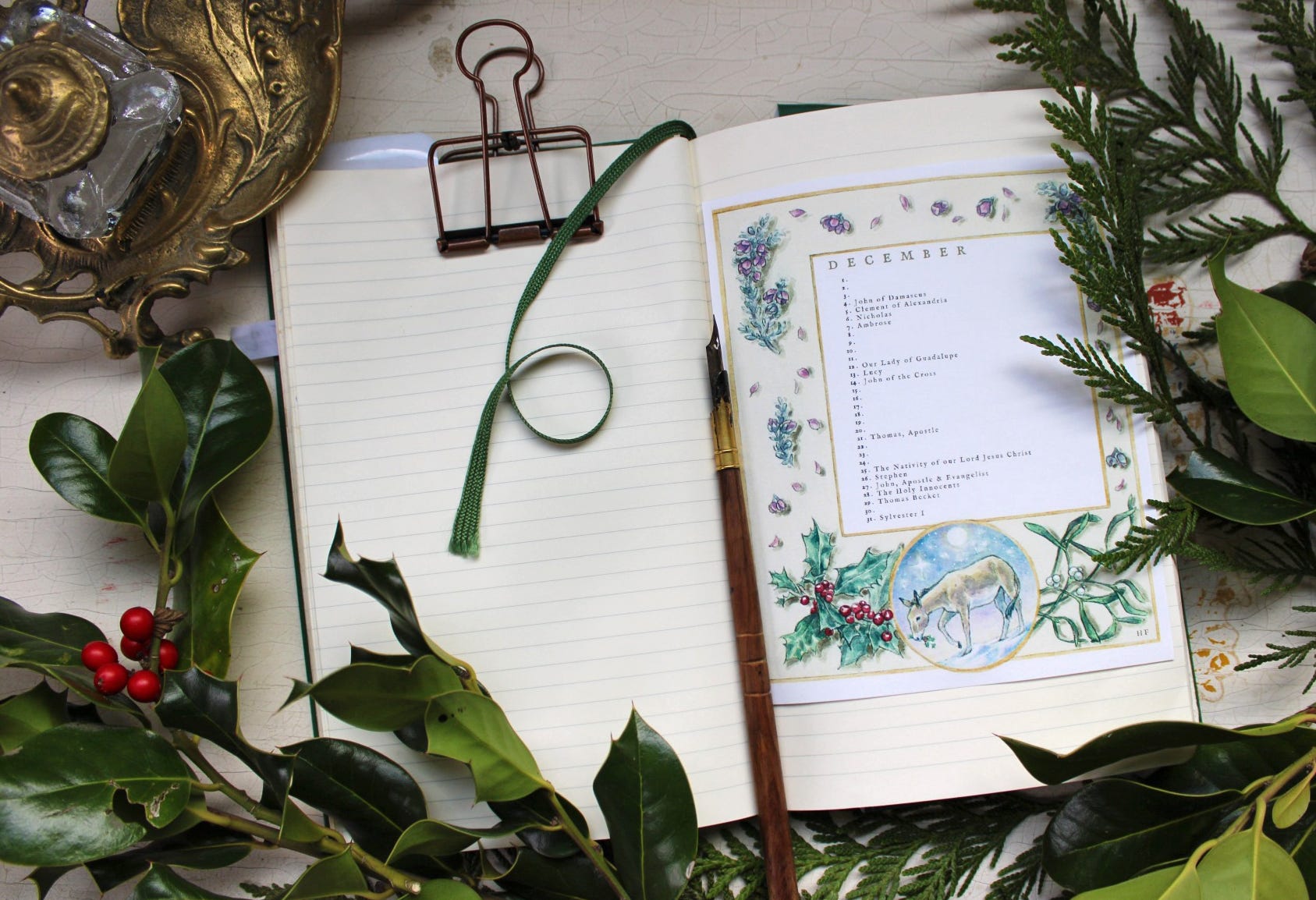

If there was such a thing as a Great Liturgical Baking Show (like the Great British Baking Show), I bet Thomasmas Medieval gingerbread would win biscuit week. 🙌😂 What a lovely idea, ties in both the season and his role of architect so beautifully. Going to add to my Advent baking list!
Most of the year, the bread I bake is made with white bread flour, or a mix of white and sprouted whole wheat–just flour, water, salt, and wild yeast. It's usually light and airy with an open crumb and a light caramel crust. As the days grow shorter, however, the bread I bake also get's darker–more whole wheat, or rye. Just before Christmas, I will be removing the water and adding buttermilk and stout beer. I'll add some brown sugar, cinnamon, nutmeg, and clove. When the loaf is ready to shape, I will fold in dried cranberries and pecans and a few chocolate chips. It has always just felt right, felt better and more appropriate, to bake and enjoy this kind of bread during this time of the year. How delightful it was to read this article and learn that my propensity toward a darker, sweeter, and fruitier bread comes from a long tradition that is interwoven into the church calendar! What a wonderful read this was, one that I will come back to over the next couple of weeks.
As for gingerbread houses, I think the idea of purposely making it a house that lays down is a great idea, especially for me, because that is where the pieces of my gingerbread house always end up anyway. :-)
Also, I am thinking of getting these house cake molds. Plus, the book looks adorable. https://www.thetomtecake.com